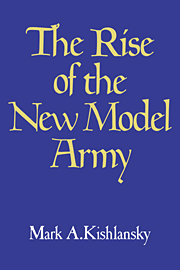2 - The Creation of the New Model Army
Published online by Cambridge University Press: 17 September 2009
Summary
This Army, under God, is the principal means to preserve us in safety.
Another year had passed and Parliament's hope that its conflict with the King would be resolved in 1644 had faded with the leaves. “The harvest is past; the summer is ended and we are not saved,” Thomas Hill drew from Jeremiah in his fast-day sermon “The Season for England's Self-Reflection.” Through spring and summer Parliament's armies had been triumphant, relieving York and defeating the royalists in battle at Marston Moor. But the seeds of victory had yielded no crop. In September, after an ill-advised march into Cornwall, the Earl of Essex had surrendered his entire infantry to the King at Lostwithiel. A month later the regrouped parliamentary forces had engaged in a reluctant battle at Newbury. This encounter proved indecisive but was followed by the humiliation of Charles's unopposed relief of Donnington Castle. With the autumn rains the military campaign yet again had ended in a stalemate. The collapse of its armies ensured Parliament another winter of discontent.
At Westminster the military failures precipitated a twofold reevaluation of the parliamentary cause. To men who equated earthly failure with heavenly wrath the Lord's judgment was unmistakable. The Assembly of Divines spent three days in September examining the meaning of Essex's defeat, “searching the cause of God's displeasure… which they divide in four sorts: (1) their own sins; (2) the Parliament's sins; (3) the Army's sins; (4) the sins of the people.”
- Type
- Chapter
- Information
- The Rise of the New Model Army , pp. 26 - 51Publisher: Cambridge University PressPrint publication year: 1980



